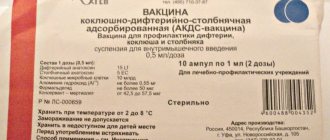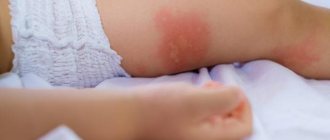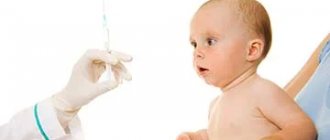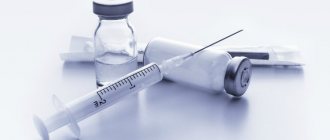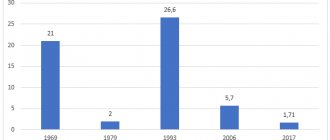DTP vaccination is carried out at 3, 4, 5 and 6 months. Revaccination – at 18 months. Revaccination against diphtheria and tetanus - at 6-7 years old, at 14 years old. After 18 years - revaccination every 10 years.
The Gorbakov Clinic uses the combined vaccines Pentaxim and Infanrix Hexa.
Tetanus, whooping cough and diphtheria are dangerous infections that lead to serious consequences, especially in early childhood. Timely vaccination with DTP, an adsorbed pertussis-diphtheria-tetanus vaccine, helps prevent them. At Professor Gorbakov’s Clinic, it is carried out with safe imported combination drugs “Infanrix Hexa” and “Pentaxim”.
Why are these diseases dangerous?
- Whooping cough is especially difficult in infants. Causes damage to the respiratory system, severe coughing and convulsions. At the beginning of the twentieth century, this disease was one of the main causes of child mortality.
- Diphtheria is a bacterial infection that causes severe inflammation of the upper respiratory tract. Formations in the larynx and trachea provoke suffocation.
- Tetanus enters the body from the soil through skin lesions. Leads to muscle dysfunction and cramps. The risk of death in the absence of adequate treatment is very high.
Pertussis-diphtheria-tetanus vaccine adsorbed liquid (DPT vaccine)
FSUE NPO Microgen, Ministry of Health of the Russian Federation, Russia
Release form: 1 ampoule/2 doses No. 10.
Vaccination schedule: prevention of diphtheria, whooping cough, tetanus according to the National Vaccination Calendar for children three times with an interval of 1.5 months (3 months - 4.5 months - 6 months).
INSTRUCTIONS FOR USE DPT - Pertussis-diphtheria-tetanus vaccine adsorbed liquid (DTP vaccine)
Pertussis-diphtheria-tetanus vaccine adsorbed liquid (DTP vaccine) suspension for injection Composition. The DPT vaccine consists of a suspension of killed pertussis microbes and purified toxoids, tetanus and diphtheria, adsorbed on aluminum hydroxide. Preservative – merthiolate at a concentration of 0.01%. 1 ml of the drug contains 20 billion pertussis microbial cells, 30 flocculating units (LF) of diphtheria antitoxin-binding units (EU) of tetanus toxoid. One primary dose (0.5 ml) contains at least 30 international immunizing units (IU) of diphtheria toxoid, at least 60 IU of tetanus toxoid and at least 4 international protective units of pertussis vaccine. It is a white or slightly yellowish suspension that separates when standing into a clear liquid and a loose sediment that easily breaks up when shaken. Properties. The introduction of DTP vaccine into the human body causes the formation of specific immunity against whooping cough, diphtheria and tetanus. Purpose. The drug is intended for routine prevention of whooping cough, diphtheria and tetanus in children aged 3 months and older according to a special regimen. Application. Vaccinations with DTP vaccine are carried out at the age of 3 months. Until the age of 3 years, 11 months and 29 days. (Children who have had whooping cough are vaccinated with ADS toxoid). The DTP vaccine is administered intramuscularly into the upper outer quadrant of the buttock in a dose of 0.5 ml (single vaccination dose). The vaccination course consists of 3 vaccinations with an interval of 1.5 months (3 months, 4.5 months, 6 months). The DPT vaccine can be administered simultaneously with the polio vaccine and other drugs on the national vaccination schedule. Revaccination is carried out once at the age of 18 months. (in case of violation of vaccination schedules - 12-13 months after the last vaccination with DPT vaccine). Note: If the child reaches 3 years 11 months 29 days. has not received revaccination with DPT vaccine, it is carried out with ADS-toxoid (for ages 4 years - 5 years 11 months 29 days) or ADS - M-toxoid (6 years and older) Contraindications. Progressive diseases of the nervous system A history of afebrile convulsions Development of a strong general reaction to the previous administration of the DTP vaccine (increase in temperature in the first two days to 400 and above) or complications. Note. 1. Children with contraindications to the use of DPT vaccine can be vaccinated with DPT toxoid. 2. If the child is vaccinated twice, the course of vaccination against diphtheria and tetanus is considered complete; if the child has received one vaccination, vaccination can be continued with ADS-M toxoid, which is administered once no earlier than after 3 months. In both cases, the first revaccination is carried out with ADS-M toxoid after 9-12 months. After the last vaccination. If a complication develops after the third vaccination with DTP vaccine, the first revaccination is carried out with DTP-M toxoid after 12-18 months. Subsequent revaccinations are carried out at 7, 14 and every subsequent 10 years with ADS-M toxoid. Release form. DTP is produced in ampoules of 1.0 ml (2 vaccination doses). The package contains 10 ampoules. Storage. Store in a dry, dark place at a temperature of (6 ± 2) ° C. Protect from freezing! Best before date. 1 year 6 months
← Back
Vaccination schedule
DTP vaccination against diphtheria, tetanus and whooping cough is carried out, according to the generally accepted vaccination calendar in Russia, at 3, 4.5 and 6 months. The interval between vaccinations is 30-45 days. If it was not possible to make the first injection at 3 months, the regimen can be started at any time, observing this interval. Revaccination is done at one and a half years or a year after the third vaccination.
At the ages of 7 and 14 years, revaccination against tetanus and diphtheria is recommended - with the ADS-M vaccine or its analogues. This allows you to maintain immunity at the required level. Vaccination against whooping cough is relevant for young children: revaccination against it is not done.
WHAT DOES THE DPT VACCINE CONSISTE OF?
The DPT vaccine consists of three components: purified diphtheria toxoid, purified tetanus toxoid and killed pertussis bacilli. Because of the last component, it is also called whole cell. It is used only for young children, since the older the child becomes, the more acutely he reacts to the pertussis component of the vaccine. Therefore, WHO recommends using DPT for primary vaccination of children, and revaccination with softer, acellular alternatives, in which killed pertussis bacilli are replaced with fragments of the cell wall of these bacteria, and the cells themselves are destroyed during the manufacturing process of the vaccine. It is the acellular vaccine against pertussis, diphtheria and tetanus (AADT) that is recommended for use in children over 6 years of age and adults.
DTP at the Gorbakov Clinic
Specialists at the Gorbakov Clinic use combined imported vaccines in practice. Vaccinations are given intramuscularly in the thigh, and for older children - in the shoulder - in compliance with the rules of asepsis. Before immunization, the child undergoes an examination by a pediatrician and also takes a general clinical blood test to ensure that there is no inflammatory process in the body.
If your baby is predisposed to allergies, he will be examined by an allergist who will recommend a safe medication to reduce a possible allergic reaction. At the preliminary consultation, parents will receive the necessary recommendations on how to prepare their child for vaccination:
- It is better to do the vaccination on an empty stomach or not to feed the child at least an hour before it.
- You should not introduce new complementary foods or give your baby unusual foods the day before.
- A mild laxative may be given to stimulate bowel movements.
- During vaccination, the child should be comfortable: he should not be overheated by dressing too warmly.
After vaccination, doctors tell parents in detail how to behave in the next few days. In what cases should I give my baby an antipyretic, what schedule should I follow for walking and bathing, can I have a massage, etc. If during the post-vaccination period the child experiences unusual reactions and parents have questions, they can always contact our clinic for advice.
DTP vaccination is considered one of the most difficult in terms of possible consequences. From our own practice, we can safely say: proper preparation and compliance with all standards reduces the percentage of post-vaccination reactions to a minimum and prevents complications. Specialists at the Gorbakov Clinic approach the issue of immunization against tetanus, diphtheria and whooping cough individually, which is why many parents trust us!
HOW Vaccination AFFECTS THE SPREAD OF INFECTIONS
Before the advent of the DTP vaccine in the 1950s, infections such as tetanus, diphtheria and whooping cough caused very serious illness and even death. According to statistics, 20% of children suffered from diphtheria, and by the age of two years, almost half of the cases were fatal. Child mortality from tetanus was even higher and reached 95%. And whooping cough was almost as common as ARVI - almost 100% of children suffered from it, with varying degrees of severity. The WHO estimates that since the start of a large-scale pertussis vaccination campaign in the 1950s and 1960s, the number of cases has dropped by 90%!
In Russia, statistics also show positive figures: in 2016, there were only two cases of diphtheria infection and three of tetanus. Only about 8,000 people had whooping cough - 1.7 cases per 100,000 people. When you compare this to 1958, when there were 475 reported cases of whooping cough per 100,000 people, the statistics speak for themselves: the vaccine has indeed helped minimize the spread of the infection.
The anti-vaccination campaign that began in the 1980s led to a decrease in vaccination coverage of the Russian population to 60%, and this almost immediately affected the incidence of many infections, including whooping cough. By 1993, the number of reported cases had increased 13-fold. After the 2000s, when active public education led to an increase in the number of people vaccinated, especially children, the picture changed again.
Conditions for storing and transporting vaccines
| Name | Storage conditions. |
| Avaxim, hepatitis A vaccine | At temperatures from +2°C to +8°C (in the refrigerator). Do not freeze. |
| Agrippal, subunit influenza vaccine | The vaccine is stored at a temperature of +2° to +8° C (in the refrigerator) in a place protected from light. Do not freeze! Keep out of the reach of children! |
| AD-M, purified diphtheria anatoxin, adsorbed with reduced antigen content | The drug is stored (out of reach of children) and transported in accordance with SP 3.3.2.1248-03 at a temperature of 2 to 8 °C. Freezing is not allowed. |
| ADS, diphtheria anatoxin, purified, adsorbed | The drug is stored (out of reach of children) and transported in accordance with SP 3.3.2.1248-03 at a temperature of 2 to 8 °C. Freezing is not allowed. |
| ADS-M, purified diphtheria-tetanus toxoid, adsorbed with reduced antigen content | The vaccine is stored and transported in accordance with SP 3.3.2.028-95 in a dry place protected from light at a temperature of 4 to 8 °C. The drug that has been frozen cannot be used. |
| DTP, pertussis-diphtheria-tetanus vaccine adsorbed | Store in a dry, dark place at a temperature of (6 ± 2) ° C. Protect from freezing! |
| ACT-HIB conjugate vaccine | Store at temperatures from + 2 °C to + 8 °C (in the refrigerator). Do not freeze. Rev. 06/96 |
| Anti-rabies culture dry concentrated purified inactivated vaccine (Microgen) | The vaccine is stored and transported at a temperature of 2 to 8 ° C in accordance with Sanitary Rules SP 3. 3. 2. 028-95. The vaccine can be transported at temperatures up to 25 °C for no more than 2 days. |
| AS, Tetanus toxoid purified adsorbed liquid | The drug is stored (out of reach of children) and transported in accordance with SP 3.3.2.1248-03 at a temperature of 2 to 8 °C. Freezing is not allowed. |
| Brucellosis, live dry vaccine | The vaccine is stored and transported in accordance with SP 3. 3. 2. 028. 95 at a temperature not exceeding 8 ° C. |
| BCG, tuberculosis vaccine | Store the drug at a temperature not exceeding 8° C according to SP 3.3.2.028-95. Transportation by all types of transport at a temperature not exceeding 8° C |
| BCG-M, tuberculosis vaccine for gentle primary immunization | Store the drug at a temperature not exceeding 8° C according to SP 3.3.2.028-95. Transportation by all types of transport at a temperature not exceeding 8° C according to SP 3.3.2.028-95. |
| Vaxigrip, split flu vaccine | Store in the refrigerator (2 to 8°C), protected from light. Do not freeze. Keep out of the reach of children. |
| VIANVAC, typhoid vaccine, Vi-polysaccharide liquid | The vaccine is stored and transported in accordance with SP 3. 3. 2. 028-95 at a temperature of 2 to 8 ° C. Transportation is allowed at temperatures up to 25 °C for no more than 14 days. VIANVAC vaccine should be stored out of the reach of children. |
| HEP-A-in-VAK, hepatitis A vaccine | The vaccine is stored and transported in accordance with “Sanitary Rules 3. 3. 2. 028-95” at a temperature of 2 to 8 ° C. |
| Grippol +, influenza vaccine trivalent polymer-subunit liquid | Store in a place protected from light at a temperature of 2 °C to 8 °C. Keep away from children! Do not freeze! The drug that has been frozen cannot be used. Transportation by all types of covered transport in light-proof containers at temperatures from 2 ° C to 8 ° C, in conditions that exclude freezing. Transportation is allowed at temperatures up to 25 ° C for 6 hours. |
| Yellow fever vaccine, live dry | In accordance with SP 3.3.2.1248-03 at temperatures from 0 to 8 0C. For long distances - only by air for no more than one day. |
| Rabies immunoglobulin from horse serum (AIG) | Store in closed, dry, dark rooms at a temperature of (5?2) °C. Transport by all types of covered transport under conditions that exclude freezing and heating of the drug above 20 °C. |
| ImovaxPolio, inactivated polio vaccine | At temperatures from + 2°C to + 8°C. Do not freeze. |
| Infanrix, diphtheria-tetanus vaccine three-component acellular pertussis adsorbed liquid | In a dry, dark place at a temperature of 2–8 °C (do not freeze). |
| Inflexal | Store in a place protected from light, at a temperature of 2-8°C. Do not freeze! |
| Influvac, subunit influenza vaccine | Store in a place protected from light, at a temperature of 2°C to 8°C (in the refrigerator). Do not freeze! Keep out of the reach of children! |
| Tick-borne encephalitis vaccine culture purified concentrated inactivated dry | The drug is stored and transported in accordance with SP 3. 3. 2. 1248-03 at a temperature of 2 to 8 ° C. Do not freeze. Transportation is allowed at temperatures from 9 to 25 °C for 2 days. For long distances - only by air. |
| Combiotech, hepatitis B vaccine, recombinant yeast liquid | Store and transport at a temperature of 2 – 8 °C |
| Measles, cultured live dry vaccine (Microgen) | Storage at temperatures from 0 to 8 °C. |
| Meningococcal polysaccharide vaccine, serogroups A+C | Store at temperatures from +2°C to +8°C (in the refrigerator). |
| Meningococcal polysaccharide vaccine, serogroup ACWY | The vaccine is stored and transported at a temperature of 2 to 8°C. The solvent is stored and transported at temperatures from 2° to 25°C; freezing is not allowed. After diluting the lyophilisate with a solvent, the vaccine should be used immediately. The solution can be stored in the refrigerator for no more than 8 hours. The solution should be protected from direct sunlight. |
| Pentaxim vaccine for the prevention of diphtheria, tetanus, whooping cough, polio, hemophilus influenzae infection | Store in the refrigerator (at a temperature of 2 to 8 ° C). Do not freeze. Keep out of the reach of children. |
| PNEUMO 23, pneumococcal vaccine | At temperatures between 2°C and 8°C (do not freeze). Keep out of the reach of children. Shelf life 2 years. Do not use after the expiration date stated on the packaging. |
| Poliomyelitis oral vaccine types 1, 2, 3 | Transportation is carried out in accordance with SP 3.3.2.028-95 by all types of covered transport in frozen or liquid form at a temperature of (6±2)°C. |
| Regevak, hepatitis B vaccine, recombinant yeast liquid | Store and transport in accordance with SP 3.3.2.1248-03 at a temperature of 2°C to 8°C out of the reach of children. Short-term (no more than 72 hours) transportation is allowed at temperatures from 9°C to 30°C. A drug that has been frozen or has expired cannot be used. |
| Recombinant liquid hepatitis B vaccine | At a temperature of 2–8 °C. Short-term (no more than 72 hours) transportation is allowed at temperatures from 9 to 20 °C. |
| Dry live anthrax vaccine, for subcutaneous and scarification use | The vaccine is stored and transported in accordance with SP 3. 3. 2. 028-95 at a temperature of 2 to 10 ° C. Transportation can also be carried out at a temperature not exceeding 25 °C for no more than 20 days. |
| Tuberculin, tuberculosis allergen purified in standard dilution | The drug is stored in accordance with SP 3.3.2.028-95 at a temperature of 2 to 8 °C, transported in accordance with SP 3.3.2.028-95, under conditions that exclude freezing and overheating above 18 °C. |
| Tularemia vaccine live dry | The vaccine is stored and transported in accordance with SP 3. 3. 2. 028-95 at a temperature not exceeding 8 ° C. |
| Fluarix | The vaccine should be stored at a temperature of 2° to 8°C, protected from light; do not freeze. Under these conditions, the Fluarix vaccine can be stored for 12 months without losing its properties. |
| FSME-IMMUN INJECT, tick-borne encephalitis vaccine | Store at temperatures between + 2°C and + 8°C Do not freeze! Do not use if freezing has occurred, even for a short period of time. |
| Havrix 1440 / 720, hepatitis A vaccine | The vaccine should be stored at a temperature of 2° to 8°C; do not freeze. Shelf life: 3 years. |
| Shigellvac, dysentery vaccine lipopolysaccharide from the Sonne strain | Storage according to SP 3. 3. 2. 028-95 at a temperature of 2 to 8 ° C. Transportation is carried out by all types of covered transport at temperatures from 2 to 25 °C. Transportation at 35 °C is allowed for no more than 14 days. SHIGELLVAC vaccine should be kept out of the reach of children. |
| Engerix B, hepatitis B vaccine, recombinant yeast liquid | Store and transport in accordance with SP 3. 3. 2. 028-95 at a temperature of 2 to 8 ° C. Freezing is not allowed. Short-term (no more than 72 hours) transportation is allowed at temperatures from 0 to 30 °C. |
| Encevir, tick-borne encephalitis vaccine | Store at temperatures from 2 to 8o C. Do not freeze! Transportation at temperatures from 2 to 8o C. Short-term (no more than 24 hours) transportation at temperatures not exceeding 20 C is allowed. |
| Encepur, tick-borne encephalitis vaccine | The Encepur vaccine for children should be stored and transported at a temperature of 2°C to 8°C. Do not freeze! Do not use the vaccine after freezing. Keep away from children. |
| Euvax B, hepatitis B vaccine, recombinant liquid | Do not use after the expiration date stated on the outer packaging. Store at temperatures from +2 °C to +8 °C (in the refrigerator). Do not freeze. |
The information is for informational purposes only; see the packaging for exact storage and transportation information! The information was prepared using materials from the site https://vakcina.ru/
